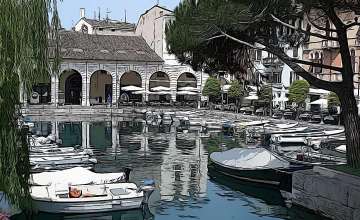Desenzano | Villa Romana
Description
At the beginning of of the 1920s, the remains of another villa from Roman times on Lake Garda came to light quite by accident. The villa is also situated in the province of Brescia, but further west, in the town of Desenzano del Garda.
The construction of the villa can be traced back to three successive phases during the period from the end of the 1st century B.C. and the 1st half of the 4th century A.d. If the villa traditionally attributed to Catullus is impressive, the Villa Romana in Desenzano wins visitors over with its splendid multi-coloured mosaics that have been reconstructed over an area of more than 240 square meters. Due to the building’s close proximity to Lake Garda
it is assumed that it once had direct access to Lake Garda with its moles and berths. It seems likely that the building was used for fishing.
As mentioned before, the mosaics give great artistic value to the site. Among the designs, grape gathering putti, chariots, wild animals, allegorical scens, and maenads and satyrs are worth mentioning. The name of the villa’s former owner is unknown, but the building’s opulence suggests that it was an illustrious and affluent person. The villa could therefore have belonged to the brother of the Roman usurper Magnentius, Flavius Magnus Decentius, whose name can be easily traced back to the town of Desenzano.
The museum seat is in the villa’s entrance area. In the “antiquarium”, it houses the finds from excavations.
Website only in Italian
Related content
-

Desenzano del Garda | Palazzo Todeschini and Villa Brunati
We go to the western shore on Lake Garda, to Desenzano del Garda, where another two buildings of our route are located: Palazzo Todeschini and Villa Brunati. -

Sirmione Castle
Going west from Peschiera, visitors reach Sirmione on Lake Garda where, on the tip of the peninsula, a castle is located. Today, Sirmione belongs to the province of Brescia. -

Desenzano
Desenzano is a popular holiday resort known for its bustling activity and its nightlife.



